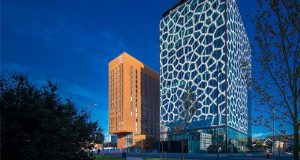 To get a feel for the sort of bespoke end-of-route facilities landlords and their tenants can aspire to offer, we met up with Sires to see the brand-new end-of-route facilities at Foundry, an office building located at the heart of the Assembly development in London’s Hammersmith area. The 10,637 sq m offices can be accessed from the riverside paths and quiet side roads of Hammersmith, so it’s already an attractive prospect for those who’d prefer to commute by bike. The basement area includes lockers and changing rooms, a drying room, bike maintenance areas and 161 secure cycle storage spaces.
To get a feel for the sort of bespoke end-of-route facilities landlords and their tenants can aspire to offer, we met up with Sires to see the brand-new end-of-route facilities at Foundry, an office building located at the heart of the Assembly development in London’s Hammersmith area. The 10,637 sq m offices can be accessed from the riverside paths and quiet side roads of Hammersmith, so it’s already an attractive prospect for those who’d prefer to commute by bike. The basement area includes lockers and changing rooms, a drying room, bike maintenance areas and 161 secure cycle storage spaces.
Says Sires: “The space includes graphics-based wayfinding on the walls so that people can see where they’re headed, unisex lockers, with power to recharge and even an iron station, complete with timer switch to avoid people leaving it on. In a limited space we managed to ensure some of the lockers drop down below the bench to give users full-height hanging space. We also provide useful extras such as shoe storage underneath and what we call a dry bench, for hairdryers, mirror and so on.”
Five at Heart also offers a towel service. “This leads to a cleaner, more welcoming environment,” says Sires. “We deliver that ourselves, currently to around 150 buildings, so this means we’re offering the design, the product installation and the ongoing servicing.”
For commuters who want to cycle on an ad hoc basis, the building includes its own Brompton bike hire scheme. There is also a range of pool bikes for tenants and bike lockers for cyclists with their own portable bikes.
Foundry is just one of several installations completed by Five at Heart since moving into the European market. At Bedford Street in central London there are different types of bike parkers to optimise the space, along with a bike service station, lockers with power for recharging phones, and drying facilities for wet clothing. “Over the last two years we’ve been involved in over 100 designs [in the UK] as people realise it requires more than box ticking,” says Sires. “But it’s not necessarily costing them any more to get that great outcome.
 “Our aim is to be a driving force to deliver a higher quality of facility and make people more inclined to install bike storage and facilities. From an owner perspective they don’t want white elephant facilities that don’t get used.”
“Our aim is to be a driving force to deliver a higher quality of facility and make people more inclined to install bike storage and facilities. From an owner perspective they don’t want white elephant facilities that don’t get used.”
This is where the free Five at Heart cycle heart rating comes in. Tenants and end users can use it to see how their facility compares with others across the world. The assessment process involves an interview or site visit by one of the Five at Heart team and completion of a survey via the app. The facility will instantly receive its score out of 100 – a rating above 75 per cent earns certification. A cycle heart rating report card is then issued with all the criteria and ratings, so users can see what works and where there’s room to improve.
FRIENDLY RECEPTION
Quality fixtures and features are one thing. An equally important factor is the attitude of management towards the facilities. How well does the organisation support provision for cyclists? This is why the assessment process includes finding out how cyclists are treated in reception when they arrive with their bike.
“If they look at you blankly it isn’t good,” says Sires. “We’re not only analysing the numbers of bikes accommodated or the specs, but how an organisation is managing the space. Do they have information about the end-of-route facilities? Are there champions promoting the space? If you’ve a security guard on the door who welcomes visitors on bikes rather than looks at them suspiciously, that will feed into how bike-friendly the building becomes. This includes making it easier for cyclists to arrive directly into the bike area to sort out their bikes and then report in.”
For instance, he argues, property managers should aim to make it easier for users to simply cycle directly down a dedicated cycle track into a building rather than, as is the practice in some buildings, make them take the pedestrian access – which often involves stairs. This is done to avoid cyclists sharing entrance space with car drivers, but as Sires points out, people will still use the main route into the building, and adding a cycle track will at least make it safer.
This is the kind of cultural issue that need to be addressed in our modern office buildings, as the BCO report notes. Concludes Sires: “We’re delivering on that dream of getting more people to experience the freedom of the ride by having these great facilities for them to use when they get to the office.”




